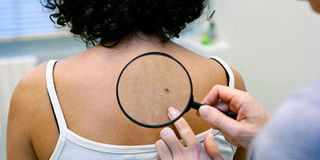Skin disorders could be a sign of an underlying condition

If you notice changes in a mole’s colour, height, size, or shape, you should have a dermatologist evaluate it. You also should have moles checked if they bleed, itch, or become painful.
What you need to know:
While most skin disorders should not be cause for alarm, dermatologists warn that some could be underlying systemic disorders and should be treated with urgency.
Could that rash, bump or mole be a sign of a more serious medical condition? Apart from its basic functions of protection, regulation and sensation, the skin is a window to what is going on inside the body, and changes to it may signal a serious health problem.
Doctor George Ogwang, a dermatologist from The Skin Specialist’s Clinic in Wandegeya, classifies skin disorders as; the primary skin diseases which are limited to the skin and those that present on the skin that are a sign of an underlying disease. He mentions some of these conditions as discolourations that can imply liver disease, itchy skin that might be a sign of kidney failure or fat deposits on the skin that might signify limpid disorders such as heart failure.
Body growths
There are a number of skin conditions that cause lumps and bumps to appear on the surface or just below the skin. Not all skin cysts, tags, lumps and bumps are malignant and can be easily treated or surgically removed. However, Dr Ogwang says if any of these skin disorders appear spontaneously and continue to grow steadily over weeks, it is advisable to see a specialist.
“Any lumps that are larger than two inches (about the size of a golf ball), grow larger, or are painful regardless of their location point to a potentially life-threatening condition,” he adds. Most people do not pay attention to birthmarks or congenital nevus, but it could easily become malignant.
According to Dr Ogwang, congenital nevi should be about 20cm but if it continues to grow, the risk of melanoma development also increases.
Skin discolouration
Normal skin is given its colour by a substance called melanin. Too much melanin causes a condition known as hyperpigmentation. Dr Ogwang says hyperpigmentation is often a sign of a reaction to certain drugs such as birth control pills, pregnancy, too much iron in the body or endocrine diseases such as diabetes or thyroid disorder. Yellowing of the skin on the other hand can indicate liver disease.
Itching
Dr Ogwang explains that itching may be associated with skin lesions such as rash, blisters, bumps, or redness of the affected area. Persistent and generalised itching all over the body can be a sign of chronic medical conditions such as liver disease. Stress, anxiety, or other emotional problems are also known to cause itching.
Rashes
Many infections can cause a rash in addition to other symptoms. “It is important to make sure the rash is not due to a serious infection such as lupus,” adds Dr Ogwang.
According Medical News Today, an online publication, 80 per cent of lupus patients experience skin rashes, including butterfly-shaped rashes on the face and a rash on areas exposed to sunlight, such as the face, arms, neck and hands. Dr Ogwang recommends seeing a specialist when a rash fails to respond to general treatment.
Toxic ingredients to avoid in skin care products
In 2013, giant Cosmetics Company Johnson and Johnson were sued by thousands of women claiming that the brand’s Baby Powder and Shower-to-Shower products caused their ovarian cancer diagnosis. They claimed that for decades, they applied talcum powder to their genitals every day to absorb odours and moisture because they were told it was perfectly safe, even though evidence suggested that it was not. If baby powder can be that dangerous how safe are other products? To answer the question, skin care expert, founder and Managing Director Good Hair Collective Charlyn Kentaro lists the most toxic ingredients to look out for when buying skin care products. “When buying body care products take time to read the whole list of ingredients but it is also important to know what you are looking for,” Kentaro advises.
Parabens: These are preservatives mostly used in Makeup, shampoo, moisturizer and shaving creams. They are highly toxic because they disrupt the endocrine system which can potentially lead to breast cancer or early puberty.
Phthalates: They are found in nail polish, perfume and shampoo; they have been linked to decreased hormone levels, endometriosis, low sperm quality, obesity, and resistance to insulin, ovarian aging, and even cancer.
Formaldehyde: This is the preservative found in perfume, hair products and nail polish is a known human carcinogen.
When buying lipstick, look out for lead which is known to cause developmental, reproductive, kidney, blood and respiratory toxicity and cancer.
Parfum: This is catchall for hidden chemicals, such as phthalates. Fragrance is connected to headaches, dizziness, asthma, and allergies.
Hydroquinone: This is mostly used for lightening skin is highly toxic and is linked to cancer and reproductive toxicity.
Mercury: It is found in mascara and eye drops impairs brain development.
Paraphenylenediamine (PPD): It is used in hair products and dyes, but toxic to skin and immune system.
Talc: Similar to asbestos in composition, it’s found in baby powder, eye shadow, blush, deodorant. Linked to ovarian cancer and respiratory problems.




